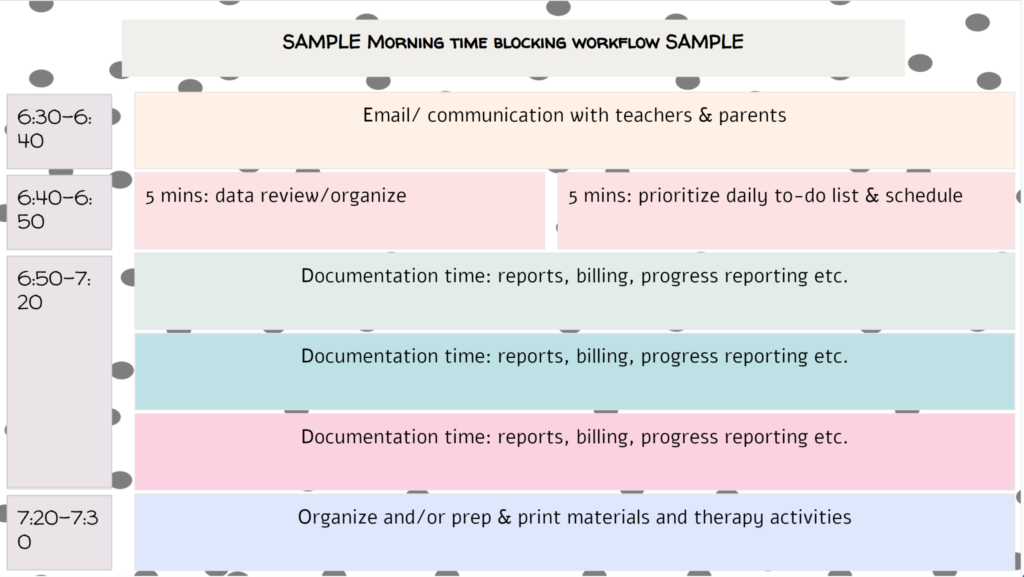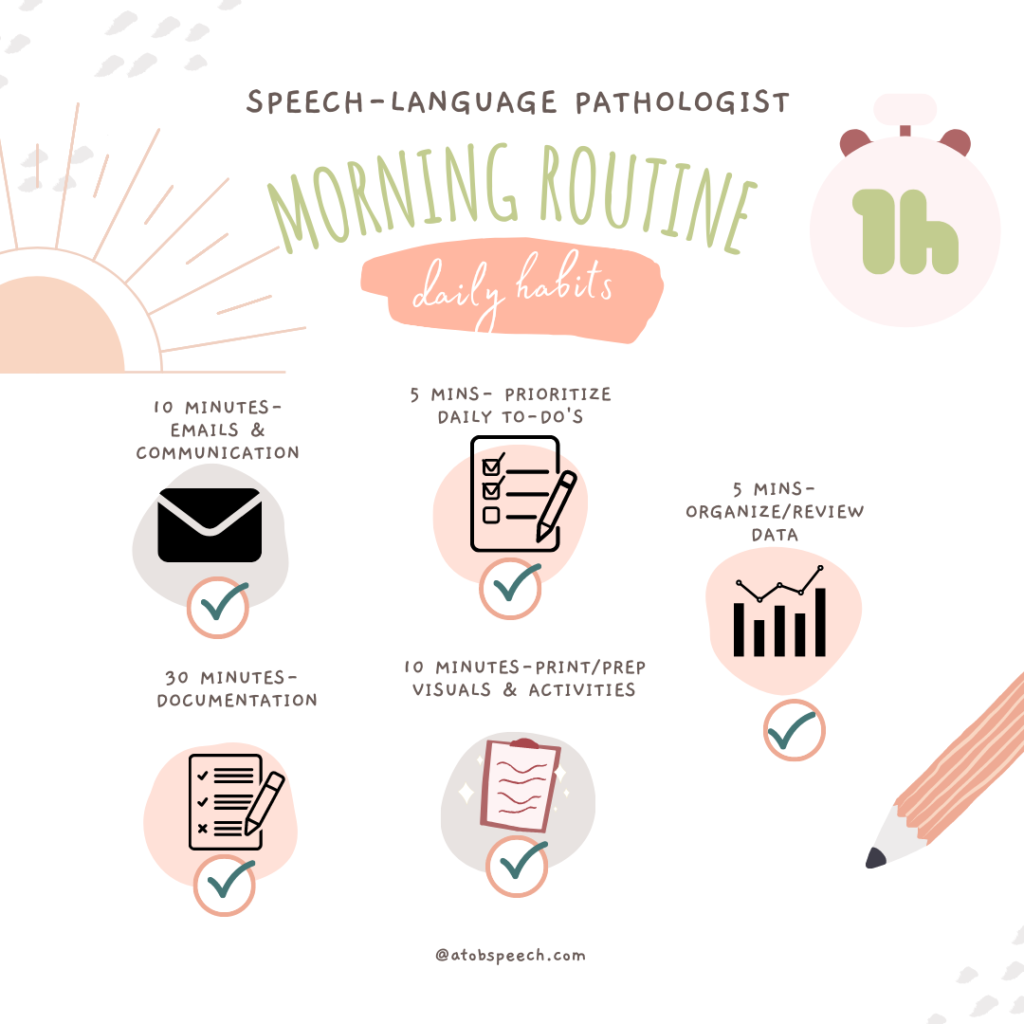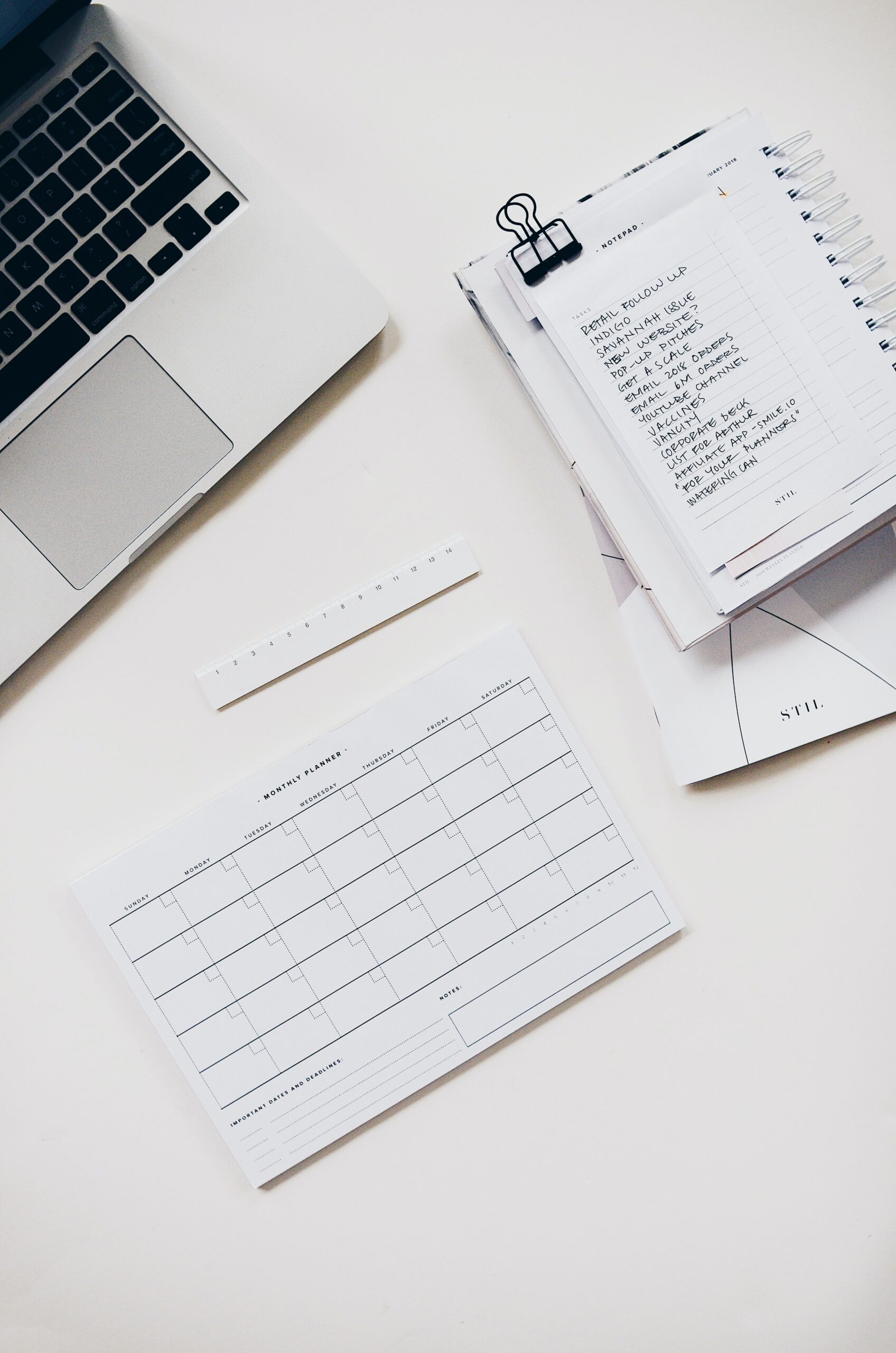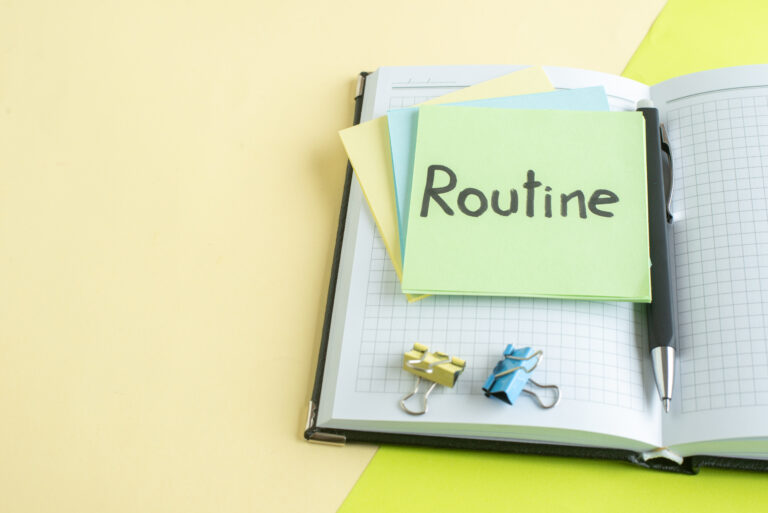Productive daily routines are THE key to saving your sanity! If you are anything like me, you often sit at your desk as the kids rush out the door after the bell rings and wonder how in the world none of your to-do list items are checked off. Sound familiar? Sometimes having a productive day at work takes planning ahead of time and prioritizing time for daily habits that will help you feel like you were able to check things off of that ‘productive day to-do list’ (the best feeling, right?). We are going to dive into creating a habits list with a simple daily routine that includes 5 daily habits that you can implement for a more productive and successful day. We are going to walk through the steps that you can take to make your own morning routine with block scheduling time management, a productive day to-do list, easy daily habits, and a morning workflow to boost your therapy productivity.

This post may contain affiliate links, this means that we could receive a commission when you click on one of our links and purchase something that was recommended. In some cases, we may be compensated for writing this post. Don’t worry, it is at no extra cost to you and all opinions and recommendations shared are truly our own! See our full policy here
Step one- planning your time management routine
The very first step in creating your ideal daily routine for your productive day is to create a block in your day that you will use to implement a set of daily habits. Pick a time in the morning that will work for you and dedicate at least one hour of serious ‘headphones-in, head-down’ working time (Hint: I like to get to school a little bit early and then indicate that I am doing paperwork with my door sign so that others know that I am there and available even if my door is closed). When I create my schedule, I like to plan in at least one hour of uninterrupted time in the morning where I can implement this workflow. If you want to learn more about my visual schedule system, you can read our post here. Once you have your hour planned in, we are going to create blocks of time for the highest priority tasks. A big part of productive daily routines is to build in priorities. To do this, ask yourself these easy questions:
- What do I find myself behind on at the end of the day or week?
- How long is this going to take me?
- Example: I am always taking reports home to write- it takes me about 2.5 hours to write, analyze, and proofread a report. This means I need about 30 minutes a day per week to write a report.
- How long is this going to take me?
- What can I do in the morning that would increase my therapy productivity?
- how can I break this down into smaller tasks?
- Example: I can plan my therapy sessions for the week and print/laminate all of my worksheets. (smaller tasks: pick a book or theme, choose 1 worksheet or game per goal/target skill, print out or prep materials and worksheets needed)
- how can I break this down into smaller tasks?
- How can I organize my day?
- Example: I can write out a ‘target of the day’ on the board every morning for each kiddo to practice when they come into the room
Step two: creating your block scheduling time management routine
Now that we have our priorities aligned, we are going to continue our productive daily routines process by creating time blocks within our hour to help us plan out specific tasks. Time blocking, or assigning a specific amount of time for specific task types, is the basis of our time management routine because we can A) set timers to help us maintain focus and B) begin the tasks right away rather than wasting time deciding what task to do first. I also like to use block scheduling for time management at work because my tasks change from day-to-day, and sometimes certain tasks take precedent over my daily to-do’s, so allowing myself flexibility within those blocks is perfect for creating structure without limiting your time.
I have created a FREEBIE template for you here so that you can create your own block schedule. If you would like to create your own with a different style, here is how: How to create your own visual for your time blocking
- Create a template in google slides with your hour block of time and break it down into 5 or 10 minute time slots (you can do this with text boxes or a table)
- Select the entire page and click ‘control + d’ (this will duplicate the page for you so that you have a template that you can go back and edit if needed)
- Create text boxes to overlay on top of your schedule (if you set it as the theme) OR edit the text boxes in the table your created (PS: I love to use Coolors to help me pick out the best color palates for my schedule. You can check out my link HERE to pick out colors that you like)
Some tasks to consider adding to your morning schedule (See my sample schedule below)
- Documentation tasks: report writing, progress notes, goal writing, writing IEP’s
- Communication tasks: checking in with teachers, sending/reading emails, family communication tasks, creating a monthly newsletter etc.
- Data tasks: creating graphs with student data, copying data from written form into your digital/paper data system, evaluating student progress to inform therapy
- Prepping and Planning tasks: planning therapy, picking out worksheets or activities to match the monthly theme, choosing targets of the day for the kids to practice, batch prepping tasks (e.g. printing tasks, laminating tasks etc.). If you want to see a prep with me video where I go in-depth about my prepping hacks/tips, click here.
- Scheduling tasks: adjusting schedule, adding new tasks to schedule, rearranging schedule for meetings etc.

Step three: Building your 5 daily habits
The last step of building your ideal productive daily routine is to build your 5 daily habits. These habits will align with the block schedule that you created. These are small tasks that can be adjusted based on the priorities of the day and are generally the cornerstone tasks of your job, another words, think about what tasks you need to do daily in order to accomplish the larger parts of your job. These will be different for each SLP, depending on your setting and your daily priority list, but to give you an idea to go off of, here is a list of my daily habits (I incorporate them into my time blocking task areas based on the priorities each day).
- Emails & Communication tasks- spend 10 minutes every morning chipping away at any communication tasks that you need to accomplish that week
- Parent and family communication tasks- newsletter, email updates etc.
- Teacher communication tasks- sending emails or coordinating meeting times to talk about progress, strategies, teacher handouts etc.
- Emails- read and respond to emails
- Gaining information- sending out questionnaires, forms, etc.
- Prioritizing Daily List
- Spend about 5 minutes prioritizing your daily to-do list. I like to use a weekly overview page for my to-do list at the beginning of the week and roughly assign tasks to each day. Then, in the morning, I will transfer that to-do list IN ORDER by my top priorities on my daily sheet. I also like to set an intention for the day (e.g. practice a 1-minute gratitude in each session today; go out of your way to say something kind today etc.- this is part of our work-life balance series on instagram). If you want to grab the templates that I use, head over to the blog post here for the freebies.
- Organize and review data
- When possible (I know things get crazy!) try to spend about 5 minutes just reviewing and organizing your data. This may just be my ‘disorganization zone’ kicking in, but sometimes I am in a rush or dealing with behaviors and I will just scribble down a note or some data on a piece of paper or in whiteboard marker on my desk. I like to take a moment in the morning to either copy over my data into my system, or if I am all caught up, I will review my student data charts (I use SLP Now for digital data so I get charts automatically created). It helps me organize my thoughts for the day about what we need to target and make sure that my kiddos are on track.
- Documentation time
- I like to spend at least 30 minutes on documentation tasks. I find that small chunks of time each day is much more manageable then trying to complete a 2.5 hour block of time all at once. Plus, if you integrate these tasks in your morning routine, you are fresh and ready to go! Even if your next report or progress note is not due until a few days or weeks out, try to start ahead of time and fill in as much as you can. I like to work from a google sheet/excel sheet with a list of my student’s PPT meetings and I start working on the next closest date. We know as SLPs we have a lot of documentation and paperwork, so setting aside even this small chunk of ‘untouchable’ time every morning for this really helps to feel more on top of the workload!
- Print/Prep time
- This is one of my favorite habits because I often find that even 10 minutes a day of printing, creating, or organizing my visuals, strategies, and materials makes all of the difference in helping me feel more prepared for the day! I like to batch these tasks, so my 5-day schedule looks a little like this:
- Monday and Tuesday-planning therapy for the next week (on these days, I am saving all of my papers to print in one folder labeled ‘print_week 4/23’)
- Wednesday- figuring out how many copies I need of each and sending all of the copies to my printer
- Thursday & Friday- laminating, creating visuals, or getting my activities organized in my file folder system (check out the complete file folder labeling system HERE).
- This is one of my favorite habits because I often find that even 10 minutes a day of printing, creating, or organizing my visuals, strategies, and materials makes all of the difference in helping me feel more prepared for the day! I like to batch these tasks, so my 5-day schedule looks a little like this:

Final Thoughts… Don’t forget your freebie!
I hope this post helped you to feel more confident in planning your very own daily productive routine with a block scheduling time management system. Using block scheduling, a simple 5 daily habits, and priority to-do lists can really help to increase your therapy productivity and give you a time management routine that goes into autopilot for you! I hope this system helps you to have a productive day at work, and most importantly, to sit at your desk after the bell rings crossing off those endless to-do’s!!
PS: don’t forget to snag your FREEBIE to help you create your own time blocking schedule and become a master of productive daily routines!







